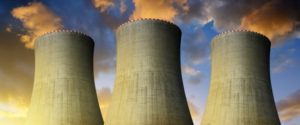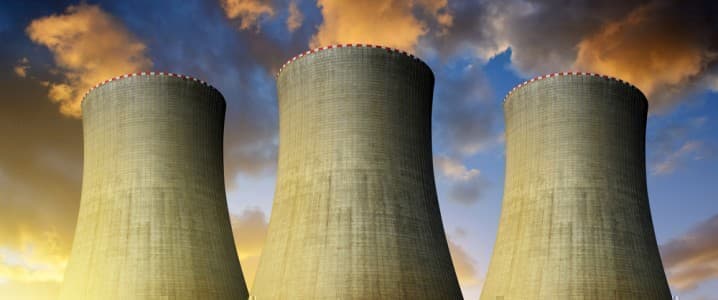 For carbon-free hydrogen to play a significant role in decarbonization, it will need to be produced in large quantities at low cost to compete with hydrocarbons. In a future power system heavily dependent on intermittent renewables, hydrogen will likely find economical use in power storage for grid balancing. However, for an actual ‘hydrogen economy’ to arise, hydrogen will have to expand into the so-called ‘hard to abate’ sectors where a large portion of carbon emissions occur. Hydrogen for direct heat in industry, and hydrogen-derived fuels (synthetic fuels such as ammonia and synthetic hydrocarbon fuels produced from hydrogen and CO2), would displace the liquid hydrocarbons now used in heavy industry (cement, chemicals, steel), heavy shipping, and aviation.
For carbon-free hydrogen to play a significant role in decarbonization, it will need to be produced in large quantities at low cost to compete with hydrocarbons. In a future power system heavily dependent on intermittent renewables, hydrogen will likely find economical use in power storage for grid balancing. However, for an actual ‘hydrogen economy’ to arise, hydrogen will have to expand into the so-called ‘hard to abate’ sectors where a large portion of carbon emissions occur. Hydrogen for direct heat in industry, and hydrogen-derived fuels (synthetic fuels such as ammonia and synthetic hydrocarbon fuels produced from hydrogen and CO2), would displace the liquid hydrocarbons now used in heavy industry (cement, chemicals, steel), heavy shipping, and aviation.
The International Energy Agency sees this shift as necessary to eventually reach carbon-neutrality in the global energy system. In its Sustainable Development Scenario, emissions in the industrial and transport sectors remain stubbornly high in 2040, far exceeding those in the power sector where significant reductions have occurred (and reach actual negative emissions by 2070).
The IEA’s scenario sees hydrogen, ammonia, and synfuels composing 1.5% of global energy consumption in 2040, but rising to almost 10% in 2070 as hydrocarbon fuels see steep declines. But the agency does not set out a clear path toward this outcome.
Some entrepreneurs claim they can already provide carbon-free hydrogen at $2/kg. But others see that a much steeper fall is required, toward $0.90/kg for hydrogen-based fuels to replace liquid fuels at a large scale in the aviation and shipping sectors. Whether this can be achieved even by mid-century is unclear, leading many observers to call for various forms of a carbon tax to make clean hydrogen viable.
In any event, reaching the lower price points will require innovation, including innovation in nuclear power. The future of green hydrogen may well depend on research and innovation occurring now in advanced reactors and nuclear fuels in the United States and abroad.
Going nuclear
A nuclear plant’s electricity and heat can power electrolysis for carbon-free hydrogen production. The concept is just beginning to be demonstrated at existing light water reactors in the US.
Researchers are also looking at utilizing light water reactors for high-temperature steam electrolysis, which offers efficiency advantages over lower temperature water electrolysis. This will require augmenting the heat produced by the plant to reach the temperatures required for more efficient steam electrolysis.
Related: India: OPEC+ Decision Could Derail Oil Demand Recovery
This approach may prove viable while development continues on advanced high-temperature reactors. Meanwhile, the development of small modular reactors to potentially produce electricity for low-temperature electrolysis is also occurring.
Much of the research in the US is occurring through programs at Idaho National Laboratory (INL), which is the lead national laboratory for nuclear energy research, development, and demonstration. INL is working with corporate partners on numerous projects, including the demonstration of electrolysis technology currently operating light-water nuclear plants.
Important support for INL’s ongoing work with commercial partners comes from the U.S. Department of Energy’s H2atScale initiative. As part of this the country’s largest nuclear plant operator, Exelon Corporation, has agreed to host a 1-MW electrolyzer at one of its plants, which could be operating by 2023 producing hydrogen for use on-site or for sale. The demonstration will allow simulation of scale-up to a larger hydrogen production unit.
Another commercial partner is Energy Harbor Corp., which emerged from bankruptcy last year and continues to operate several nuclear plants. The company is planning a demonstration of commercial electrolysis at its Davis-Besse nuclear plant, a single-unit plant located on the Lake Erie shore near Toledo, Ohio. The two-year project will seek to deploy a 1- to 3-MW low-temperature electrolysis unit to produce commercial quantities of hydrogen.
A demonstration of high-temperature steam electrolysis is also being planned at a currently operating light-water plant. The process requires heat augmentation to power electrolysis for hydrogen production at high temperatures (approx. 1000 degrees C). Minneapolis-based Xcel Energy was recently selected for the demonstration with $11 million in federal funding.
“The project is the first of its kind in pairing a commercial electricity generator with high-temperature steam electrolysis technology,” says Richard Boardman at INL. He is the national technical lead for the DOE Light Water Reactor Sustainability Program’s Flexible Plant Operations and Generation Pathway.
“The resulting hydrogen will initially be used at the power plant, but it could eventually be sold to other industries – especially if followed by a scale-up in the hydrogen production capabilities,” he adds.
INL intends to expand its cooperation with commercial partners to install hydrogen electrolysis systems in currently operating light water nuclear plants, assembling electrolyzer stacks in order to continue to test and develop these systems. Moreover, the lab is considering the eventual deployment of advanced high-temperature reactors specifically for steam electrolysis. Several different advanced reactor concepts are currently in development worldwide, many being designed as microreactors or small modular reactors.
“Sodium-cooled fast reactors, molten-salt reactors, and high-temperature gas reactors could achieve greater efficiency in the process because their higher operating temperatures improve the efficiency of electricity generation,” says Richard Boardman. “And electricity still makes up most of the power used in steam electrolysis.”
Small reactor speculations
The need for nuclear in carbon-free hydrogen production took on urgency in a recent panel discussion, part of the Atlantic Council’s Global Energy Forum, entitled ‘Nuclear Beyond Power: Hydrogen, Heat, and Desalination.’
Kirsty Gogan, who is Managing Partner at the consultancy LucidCatalyst in the UK, said that according to her firm’s calculations, the target price point of $0.90/kg can be reached by 2030 with ‘advanced heat.’ In this case, the term refers to collections of small modular reactors.
LucidCatalyst published a report last fall called ‘Missing Link to a Livable Climate: How Hydrogen-Enabled Synthetic Fuels Can Help Deliver the Paris Goals.’ It conveys interesting proposals for the large-scale production of green hydrogen, to occur much more quickly than what is envisioned in the IEA’s scenario.
The authors argue that large-scale production of green, low-cost hydrogen for synthetic fuels cannot be done competitively with electrolysis powered by renewable energy, perhaps not even by mid-century. They argue the actual land requirements for that would be too great. Moreover, they point out that wind and solar power do not produce heat as a primary energy product, and therefore can only be applied to less efficient low-temperature electrolysis.
Related: Oil Soars As OPEC+ Sources Suggest No Production Increase
They recommend instead “a new generation of advanced heat sources,” which are actually advanced modular reactors (see report p. 26), which power electrolysis with heat. And they argue that the production of such reactors can occur in large numbers and economically with advanced manufacturing and standardization, at or close to ports and shipyards.
Modern shipyards offer them important models of the kind of large-scale, low-cost production they are seeking. One format would be a floating production platform, moored near a harbor, deploying high-temperature modular reactors for high-temperature electrolysis dedicated to the production of hydrogen and its conversion to ammonia for ship fuel. The report compares capital and operating costs for light water and molten salt small modular reactors to show the cost advantages of advanced nuclear technologies (report, p. 49).
Another suggested format is a ‘gigafactory’ with small modular reactors built on the site itself, for concentrated, large-scale hydrogen production close to ports and rails. The report contains impressive illustrations of what these facilities might look like someday, should they ever be built.
These ‘advanced heat’ schemes will no doubt be followed by many more in the years ahead as entrepreneurs seek to dramatically lower the cost of clean hydrogen and hydrogen-based synthetic fuels. Other panelists pointed to the real possibilities for advanced nuclear.
“The key will ultimately be producing the high temperatures needed to most effectively produce hydrogen,’ said Seth Grae, President, and CEO, Lightbridge Corporation, which is a US-based company working on advanced nuclear fuels.
“Nuclear is the only feasible way to meet this goal,” he said.
Source: https://oilprice.com/Energy/Energy-General/Why-Hydrogen-Needs-Nuclear-Power-To-Succeed.html

